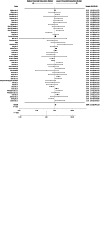Parental education and youth suicidal behaviours: a systematic review and meta-analysis
- PMID: 35352676
- PMCID: PMC8967699
- DOI: 10.1017/S204579602200004X
Parental education and youth suicidal behaviours: a systematic review and meta-analysis
Abstract
Aims: Lower parental education has been linked to adverse youth mental health outcomes. However, the relationship between parental education and youth suicidal behaviours remains unclear. We explored the association between parental education and youth suicidal ideation and attempts, and examined whether sociocultural contexts moderate such associations.
Methods: We conducted a systematic review and meta-analysis with a systematic literature search in PubMed, PsycINFO, Medline and Embase from 1900 to December 2020 for studies with participants aged 0-18, and provided quantitative data on the association between parental education and youth suicidal ideation and attempts (death included). Only articles published in English in peer-reviewed journals were considered. Two authors independently assessed eligibility of the articles. One author extracted data [e.g. number of cases and non-cases in each parental education level, effect sizes in forms of odds ratios (ORs) or beta coefficients]. We then calculated pooled ORs using a random-effects model and used moderator analysis to investigate heterogeneity.
Results: We included a total of 59 articles (63 study samples, totalling 2 738 374 subjects) in the meta-analysis. Lower parental education was associated with youth suicidal attempts [OR = 1.12, 95% Confidence Interval (CI) = 1.04-1.21] but not with suicidal ideation (OR = 1.05, 95% CI = 0.98-1.12). Geographical region and country income level moderated the associations. Lower parental education was associated with an increased risk of youth suicidal attempts in Northern America (OR = 1.26, 95% CI = 1.10-1.45), but with a decreased risk in Eastern and South-Eastern Asia (OR = 0.72, 95% CI = 0.54-0.96). An association of lower parental education and increased risk of youth suicidal ideation was present in high- income countries (HICs) (OR = 1.14, 95% CI = 1.05-1.25), and absent in low- and middle-income countries (LMICs) (OR = 0.91, 95% CI = 0.77-1.08).
Conclusions: The association between youth suicidal behaviours and parental education seems to differ across geographical and economical contexts, suggesting that cultural, psychosocial or biological factors may play a role in explaining this association. Although there was high heterogeneity in the studies reviewed, this evidence suggests that the role of familial sociodemographic characteristics in youth suicidality may not be universal. This highlights the need to consider cultural, as well as familial factors in the clinical assessment and management of youth's suicidal behaviours in our increasingly multicultural societies, as well as in developing prevention and intervention strategies for youth suicide.
Keywords: Adolescence; adolescent; country income level; geographical region; parental education; socioeconomic status; suicidal attempt; suicidal behaviour; suicidal ideation; suicide; youth.
Conflict of interest statement
The funders had no role in the design and conduct of the study; collection, management, analysis and interpretation of the data; preparation, review or approval of the manuscript and decision to submit the manuscript for publication.
Figures



References
-
- Abdeen Z, Brunstein-Klomek A, Nakash O, Shibli N, Nagar M, Agha H, Hallaq S, Kanat-Maymon Y, Juerges H and Levav I (2018) The association between political violence and the connection between bullying and suicidality among Palestinian youth. Suicide and Life-threatening Behavior 48, 95–104. - PubMed
-
- Aggarwal S, Patton G, Reavley N, Sreenivasan SA and Berk M (2017) Youth self-harm in low-and middle-income countries: systematic review of the risk and protective factors. International Journal of Social Psychiatry 63, 359–375. - PubMed
-
- Alaimo K, Olson CM and Frongillo EA (2002) Family food insufficiency, but not low family income, is positively associated with dysthymia and suicide symptoms in adolescents. The Journal of Nutrition 132, 719–725. - PubMed
-
- Allen K and Goldman-Mellor S (2018) Neighborhood characteristics and adolescent suicidal behavior: evidence from a population-based study. Suicide and Life-threatening Behavior 48, 677–689. - PubMed
-
- Amit B, Krivoy A, Mansbach-Kleinfeld I, Zalsman G, Ponizovsky A, Hoshen M, Farbstein I, Apter A, Weizman A and Shoval G (2014) Religiosity is a protective factor against self-injurious thoughts and behaviors in Jewish adolescents: findings from a nationally representative survey. European Psychiatry 29, 509–513. - PubMed
Publication types
MeSH terms
Grants and funding
LinkOut - more resources
Full Text Sources
Medical

